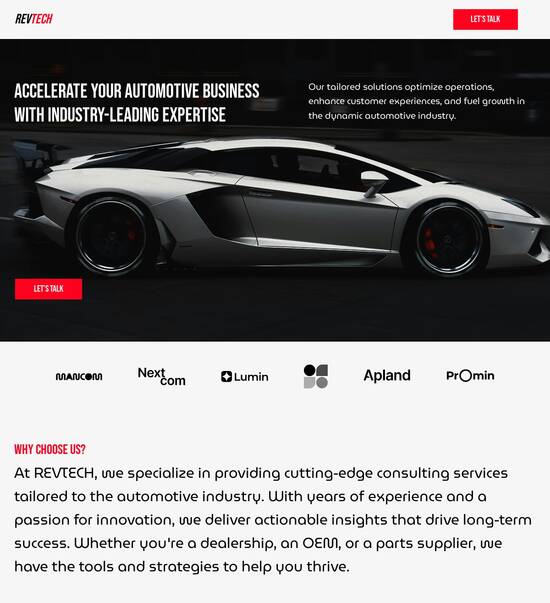
API documentation page template compatible with Wordpress
Explore Similar TemplatesAbout template
Build and integrate high-converting API documentation page templates with Wordpress effortlessly!
Recommended templates

Easy to build without coding
With the intuitive drag-and-drop builder, anyone on your team can create high-converting pages without any knowledge of code or design. Make enhancements to your landing page with custom widgets using Javascript, HTML/CSS, or third-party scripts.

Multiple layouts for any industry and goal
Select from 500+ landing page layouts built to boost conversions across industry-specific scenarios. Customize them by adjusting fonts, adding images, and generating on-brand content with the AI assistant. Quickly scale with Instablocks® and Global Blocks that you can save, reuse, and update globally.

Loads fast and looks polished on any device
Every template is responsive, which means they present professionally on any device and load blazingly fast with our Thor Render Engine. You can also power them up with Google AMP technology to deliver an unparalleled mobile experience and drive higher conversions.

Robust analytics & experimentation
Get real-time updates and reporting across all your devices, showing the number of visitors, conversions, cost-per-visitor, and cost-per-lead. Launch AI-powered experiments, run A/B tests, and use heatmaps to analyze user behavior, then optimize your landing page to maximize conversions.







Easy to build without coding
With the intuitive drag-and-drop builder, anyone on your team can create high-converting pages without any knowledge of code or design. Make enhancements to your landing page with custom widgets using Javascript, HTML/CSS, or third-party scripts.
Multiple layouts for any industry and goal
Select from 500+ landing page layouts built to boost conversions across industry-specific scenarios. Customize them by adjusting fonts, adding images, and generating on-brand content with the AI assistant. Quickly scale with Instablocks® and Global Blocks that you can save, reuse, and update globally.
Loads fast and looks polished on any device
Every template is responsive, which means they present professionally on any device and load blazingly fast with our Thor Render Engine.
Robust analytics & experimentation
Get real-time updates and reporting across all your devices, showing the number of visitors, conversions, cost-per-visitor, and cost-per-lead. Launch AI-powered experiments, run A/B tests, and use heatmaps to analyze user behavior, then optimize your landing page to maximize conversions.
All the features you need to build lead-generating landing pages
Explore more featuresLearn how to build top-performing landing pages for any goal
FAQs
Leading the way in building high-performing landing pages





Maximize Your Marketing ROI with Instapage's Powerful Landing Pages
Instapage is recognized as the foremost landing page and conversion rate optimization (CRO) platform designed specifically for marketers. This comprehensive guide will walk you through the essential steps to create high-converting landing pages that can significantly accelerate, optimize, and scale your digital marketing strategies, ultimately maximizing ROI.
Understanding the Power of Instapage
Instapage stands out due to its all-in-one capabilities that eliminate the hassle of juggling multiple tools. With over 100 customizable templates, user-friendly page builders, and pre-built lead generation elements, Instapage empowers you to launch powerful campaigns rapidly and effectively, regardless of your marketing budget and team size.
- Customizable templates: Select from a wide variety of conversion-focused layouts tailored for different industries.
- Intuitive builders: Quickly design landing pages using drag-and-drop features, ensuring a smooth user experience.
- Lead generation tools: Integrate forms and call-to-action buttons seamlessly to capture leads without technical knowledge.
Step 1: Create High-Converting Landing Pages
The first step in enhancing your marketing efforts with Instapage involves leveraging its extensive library of customizable templates. Here's how to get started:
Step 2: Optimize for Conversions
Once your pages are live, the focus shifts to optimization. Instapage's built-in experimentation features allow you to conduct A/B testing effortlessly.
- Use heatmaps: Gain insights into user behavior on your pages, identifying where to improve.
- Conduct A/B tests: Test different elements, from headlines to call-to-action buttons, to discover which variations lead to higher conversions.
- Analytics dashboard: Track performance metrics real-time to make informed decisions about your marketing campaigns.
Step 3: Implement Personalization Strategies
Enhance user engagement by delivering personalized experiences based on visitor behavior and demographics.
- Dynamic text replacement: Tailor your messaging to resonate with specific audience segments instantly.
- AdMaps: Align your ads with corresponding landing pages to ensure a cohesive message and user experience.
- Data tracking: Utilize advanced metrics tools to evaluate the effectiveness of your personalized strategies.
By following these steps, marketers can not only improve their landing page performance but also achieve a tangible increase in ROI across their campaigns. Instapage provides the tools and insights necessary to navigate this process effectively.
Ready to transform your marketing campaigns? Sign up for Instapage today and start maximizing your ROI with stunning, high-performing landing pages tailored to your audience's needs.
People also ask about API documentation page template compatible with Wordpress
API documentation page template compatible with WordPress
Understanding the basics of API documentation in WordPress
API documentation serves as a critical guide for developers and users, detailing how to effectively utilize the functionality provided by an API. It outlines how to make requests, handle responses, and interact with the services your API provides. This documentation is not always straightforward; it differs significantly from traditional documentation, which often focuses on user interfaces or specific applications. While standard documentation might explain how to use a product, API documentation is more technical, aimed at developers who need precise instructions on executing calls and managing data.
In the realm of web development, APIs have become essential for creating seamless interactions between different software applications. Consequently, clear and comprehensive API documentation plays a pivotal role in the success of any API. It not only aids users in understanding how to integrate with your service but also enhances the overall user experience by reducing potential friction points in the integration process.
The role of WordPress in API documentation
WordPress is not just a blogging platform; it serves as a versatile content management system (CMS) capable of managing complex documentation needs, including API documentation. Its flexible architecture allows developers to create, publish, and manage various types of documentation efficiently. Leveraging WordPress to host API documentation can streamline the process, making it accessible for both technical and non-technical users alike.
Additionally, WordPress offers an array of plugins and themes specifically designed for documentation purposes. These tools enhance the ability to organize and present information clearly and attractively. Utilizing WordPress as a platform for API documentation empowers developers to easily update content and ensure that their documentation is always relevant, fostering effective communication and collaboration within their developer community.
The significance of an API documentation page template
Having a structured API documentation page template is crucial for enhancing user experience. A well-defined template creates consistency, guiding users to locate information effortlessly. When users can navigate easily through the document, it alleviates frustration and significantly enhances their learning curve. Consistency in presentation allows developers and users to focus on the technical content rather than struggling with varied layouts or confusing formats.
Considering the complexity often involved in API documentation, structured templates can serve as valuable tools. They help in segmenting the documentation into clear sections, making it easier for users to digest intricate information without feeling overwhelmed. Ultimately, structured templates can lead to more effective API utilization and better user satisfaction.
Features of a well-designed API documentation page template
An effective API documentation page template is characterized by several key features that enhance clarity and usability. First and foremost is readability, which encompasses careful consideration of fonts, colors, and layout. These design elements should ensure that all users, regardless of their technical expertise, can easily read and comprehend the information presented. Clear typography and adequate spacing contribute significantly to overall readability.
Furthermore, navigation options within the template are critical. Users should find it easy to access different sections and subsections. Incorporating a table of contents, breadcrumb navigation, or well-placed links can facilitate this ease of navigation. Users can save time and become more productive when they can quickly locate the information they need.
Key elements of an effective API documentation page template for WordPress
To develop an effective API documentation page template, several key elements should be incorporated. Firstly, a comprehensive overview of the API is vital. This includes endpoint details that clearly explain what each endpoint does and how it should be utilized. Such clarity ensures developers can implement the API with minimal confusion and error.
Endpoint details: Provide a clear description of available endpoints, their purposes, and how to interact with them.
Authentication mechanisms: Detail various authentication methods, such as API keys or OAuth, so users can secure their calls.
Engaging content presentation is also crucial, and this can be achieved by utilizing well-formatted code snippets that enhance readability. Employing visual aids such as diagrams and flowcharts can further simplify complex topics, making them more accessible to both experienced developers and those new to the API.
Moreover, incorporating interactivity features like live API call demos directly from the documentation can greatly enhance the learning experience. By allowing users to experiment with the API in real-time, you bridge the gap between theory and practical application.
Technologies and tools for creating API documentation in WordPress
When it comes to creating API documentation within WordPress, several technologies and tools can streamline the process. One of the most effective methods includes utilizing specialized WordPress plugins designed for API documentation. Plugins like WP REST API Documentation Plugin, Documentor, and WP API Docs all offer specific features that cater to the unique needs of API documentation.
WP REST API Documentation Plugin: This plugin generates documentation for your REST API, focusing on endpoints and expected responses.
Documentor: A comprehensive solution for creating structured documentation, allowing for easy content management.
WP API Docs: Specifically built for presenting API references and guides with effective categorization.
Choosing the right plugin requires careful consideration of your project requirements. You should evaluate each plugin's features and functionalities against your documentation goals to ensure alignment.
Utilizing custom post types and taxonomies
WordPress allows the creation of custom post types and taxonomies, which can be leveraged to enhance the organization of API documentation. Custom post types can categorize documentation effectively, giving users clear pathways to the information they seek. For example, separate post types can be created for 'endpoints', 'authentication', and 'error messages'.
Benefits of custom post types: These enable greater flexibility in presenting content, allowing for tailored layouts and specific features.
Use of taxonomies: Utilizing taxonomies to associate related content promotes easier navigation and helps users find relevant documentation faster.
By structuring documentation in this way, developers can efficiently manage large amounts of information, ultimately leading to a better user experience. Through careful organization, technical experts can quickly find what they need without getting lost in the documentation.
Step-by-step guide to building an API documentation page template in WordPress
Creating an API documentation page template in WordPress involves several clear steps, starting with setting up your WordPress environment. Necessary installations are crucial to ensure optimal performance; this includes selecting suitable themes and plugins designed for documentation. For effective documentation presentation, configurations may need to be adjusted to align with best practices.
Choose a lightweight theme: Consider themes specifically designed for documentation to enhance performance.
Install necessary plugins: Select documentation-focused plugins that cater to your requirements.
Configure settings: Adjust permalinks and other settings to enhance SEO and usability.
Designing your API documentation template requires customization of the layout. Utilizing page builders within WordPress can simplify this process, enabling users to create visually appealing pages without extensive coding. It's essential to ensure the template features responsive design principles to guarantee accessibility across all devices, catering to a broader audience.
Once the layout is ready, you can populate the template with informative content. It’s advisable to collect data through collaborative efforts, writing clear and concise technical documentation. Structuring content effectively through bullet points and headings enhances clarity, allowing readers to grasp information quickly.
Testing and iterating your API documentation page
Testing your API documentation page is crucial. Gathering feedback from users and internal teams can reveal areas for improvement. Techniques for collecting user feedback may include conducting surveys, analyzing heatmaps, and performing user testing sessions to understand how real users interact with your documentation.
User surveys: Collect insights directly from users about their experiences and suggestions for improvement.
Heatmaps: Utilize tools to visualize user interaction, identifying hotspots and under-visited sections.
User testing: Engage actual users in testing sessions to observe their interactions with the documentation.
Iterative design is vital for maintaining an effective documentation resource. Continuous improvement contributes to the relevance and usability of the documentation, ensuring it meets users' evolving needs. Monitoring performance metrics and analyzing how documentation is accessed and utilized further assists in making informed enhancements.
Best practices for maintaining and updating API documentation
Regular content reviews and updates are fundamental to keeping API documentation accurate. Establishing a schedule for reviewing out-of-date information is crucial. It's essential to have a system for tracking changes across the API or associated services, thus ensuring the documentation reflects current functionalities.
Set a review schedule: Regularly evaluate documentation for outdated information to maintain its accuracy.
Incorporate versioning: Keep track of changes through versioning documentation, so users know what’s current.
Communicate updates: Ensure team members are informed of changes, promoting awareness and accuracy.
Engaging the community for continuous improvement is another effective strategy. Encouraging contributions from developers and users can result in a diverse range of perspectives, making the documentation more comprehensive and user-friendly. Building a culture of collaboration fosters shared knowledge within projects, ultimately leading to higher quality documentation.
Case studies: Successful implementations of API documentation pages in WordPress
Analyzing successful implementations of API documentation pages can provide valuable insights. In one case study, a tech company effectively utilized a WordPress-based API documentation template that significantly improved developer onboarding. By incorporating structured templates with intuitive navigation and a mixture of written content and visual aids, they reduced setup time by over 40%.
Similarly, a community-focused project showcased its API documentation's impact on engagement. By integrating user feedback and maintaining a clear update log, they were able to keep the documentation relevant. Developer adoption for their API surged, serving as a testament to the quality and accessibility of their documentation resources.
Analyzing the impact of quality documentation on developer adoption
The correlation between high-quality documentation and developer adoption is increasingly recognized by organizations. Higher user engagement metrics are often tied to the quality of resources provided. When documentation is clear, structured, and accessible, developers are more likely to embrace the API and integrate it into their projects.
Success stories frequently highlight organizations that have leveraged effective API documentation. By putting quality documentation at the forefront, these organizations not only improve adoption rates but also foster a community of active users contributing back to the documentation through feedback and enhancements.
Future trends in API documentation within WordPress ecosystem
As technology continues to evolve, so do the strategies employed in API documentation. The rise of AI and machine learning tools has the potential to automate aspects of documentation creation. These tools can analyze existing documentation, suggest improvements, and even keep content updated in real-time based on endpoint changes.
AI-driven automation: Tools that leverage AI to ease the documentation burden and improve accuracy.
Collaborative tools: Increasing importance of platforms that allow for real-time collaboration will be seen as teams work together more seamlessly.
Predicting user needs and expectations will also shape future documentation strategies. Accessibility and inclusiveness are becoming paramount, ensuring that all users can navigate and utilize API documentation effectively. By embracing community input and feedback, organizations can tailor their documentation strategies to meet evolving demands and foster a more inclusive developer ecosystem.
Ready to skyrocket conversions?
Supercharge your ad campaigns with high-performing landing pages
Get started














